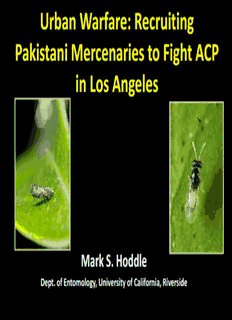
Urban Warfare: Recruiting Pakistani Mercenaries to Fight ACP PDF
Preview Urban Warfare: Recruiting Pakistani Mercenaries to Fight ACP
Urban Warfare: Recruiting Pakistani Mercenaries to Fight ACP in Los Angeles Mark S. Hoddle Dept. of Entomology, University of California, Riverside Asian Citrus Psyllid – Diaphorina citri Kuwayama (Hemiptera: Psyllidae) • ACP area of origin the Punjab region of India- Pakistan? • Widespread in SE Asia • It is a global citrus pest because it vectors a bacterium that causes HLB, a lethal citrus pathogen Distribution of ACP in California 25% of CA’s citrus grown here. Worth ~$65 million/yr Management Options • Biological Control – Use of natural enemies, in particular parasitoids of great interest for suppressing ACP populations • First work on ACP parasitoids conducted by Husain & Nath (1927) in the Punjab of Pakistan – Study sites: Sargodha, Lyallpur, and Gujranwala – 1 species named from this project, Tamarixia radiata • Parasitoids from Punjab of Pakistan are of most interest for establishment in CA because of the very good climatic match the major citrus growing regions of CA Husain & Nath (1927) reported that 9 species of parasitoid were associated with ACP in this region. Only 1 species named and described, Tamarixia radiata Possible area of origin for ACP in the Indian sub continent? Pakistan Collections • Sept. 2010 Reconnaissance completed in Pakistan • March 10 to April 10 2011 spent at UAF Pakistan looking for ACP and its natural enemies – ~5,000 psyllids collected and reared – Malaise trap set to monitor ACP and natural enemy phenology – MS student recruited and trained to work on ACP • ACP & natural enemy phenology • Flush phenology of kinnow and sweet orange • % parasitism measures and rearing of ACP parasitoids • June 4-13 2011 - ~400 parasitoids returned to UCR • Oct. 23-28 2011 - > 1,000 parasitoids returned to CA • June 16-23 2012 – > 1,000 parasitoids returned to CA Tamarixia radiata (Waterston) (Hymenoptera: Eulophidae) • First described from specimens collected from lemons in Lyallpur, Punjab, 2 Jan 1921 – Solitary ecto-endoparasitoid – Arrhenotokous: 1.8♀: 1♂ – At 25oC egg-adult = 24 days – Attacks 3rd, 4th, & 5th instar ACP – Females live 12-24 days – Females lay 166-300 eggs – Kills ACP via host feeding too
Description: